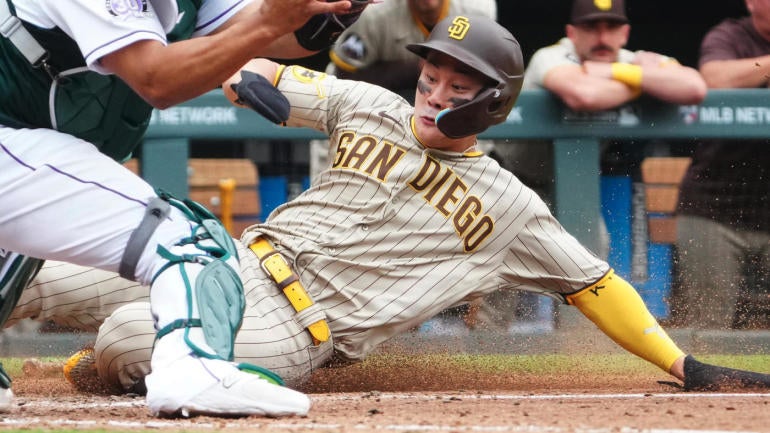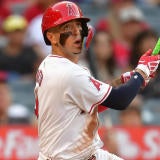
A question posed on the website formerly known as Twitter caught my attention the other day. The post was by fellow Fantasy Baseball scribe Fred Zinkie, and in it, he wondered why Aaron Judge was being drafted so much later in Round 1 than a year ago.
Almost every major projection system values Aaron Judge as a top-3 pick, which is where he landed in '23 drafts. His February NFBC ADP is 11. Recency bias? Are managers overrating the injury risk? Are projections underrating the risk?
— Fred Zinkie (@FredZinkieMLB) February 12, 2024
A year ago, you may recall, Judge was a consensus top-four pick, with some people (raises hand slowly) even campaigning for him to be No. 1. And while he didn't perform up to our expectations, he was on a 51-homer pace before tearing a ligament in his right big toe in June, making him essentially the same player as during his historic 2022. So yeah, there was the injury, but otherwise, Fred surmised, not much has changed.
You're in line with everyone else. Last year you had him 5th, which was lower than most. Not much has changed except that he smoked the wall at Dodger Stadium last June. I guess he's a year older too.
— Fred Zinkie (@FredZinkieMLB) February 12, 2024
But something has changed, hasn't it? The entire stolen base landscape has changed, and with it, so have our expectations for what a top-five hitter is capable of.
On the "not much has changed except" front, I would add that there are now several first round-caliber bats for whom we can reasonably expect 40-50 steals (one had 73, of course), which is new to fantasy baseball in general.
— Scott White (@CBSScottWhite) February 13, 2024
I mean it when I say we've never seen such massive stolen base contributions, all at the same, from players whose bats alone would put them in first-round consideration. Sure, there's been the occasional 40/40 guy, but he was always treated as a one-off, a player who got caught up in the novelty of the feat and likely wouldn't pursue it so doggedly in the future. Novelty of the feat? For goodness' sake, Ronald Acuna went 40/70 last year. Only two players before him had delivered even 30 homers and 50 steals in the same year, and the last one was in 1990 (Barry Bonds).
What needs to be stressed here is the abruptness of this change. MLB of course sought more stolen bases and introduced rules to bring it about, namely increasing the size of the bases and limiting the number of pickoff attempts, so to say no one saw it coming wouldn't be entirely accurate. In fact, I was among those shouting the loudest, in part because I observed what happened when these same rule changes were applied in the minors and in part because the league's own estimates saw us returning to stolen base numbers like those of the early 2000s. Turns out we were off by a couple decades. The number of stolen bases across the league last year was the most since 1987, representing about a 40 percent increase from 2022.
Not many people were playing Fantasy Baseball in 1987. Some were -- and they'll let you know it -- but it certainly wasn't the mainstream practice it is today. I mean, we're talking pre-internet days. We're also talking two generations ago, so even the people playing back then can't just slide back into their old approach like an old pair of pants. It's not so familiar to them anymore. And even if they could, we're now in a different environment for power and a different environment for pitching than they faced back then.
Suffice it to say no one playing Fantasy Baseball today has experienced anything quite like this before.
Acuña gets all the attention because what he did blew out all precedent, but Bobby Witt came within a stolen base of being the fourth player to deliver 30 homers and 50 steals a season. That's right: we nearly doubled the number for all of major-league history in one year. Meanwhile, Corbin Carroll -- a rookie, mind you -- became the first player (along with Acuña) to have 25 homers and 50 steals in the same season since 2007 (Hanley Ramirez) and the second since 1990 (again, Barry Bonds). And then there's Julio Rodriguez, whose 32-homer, 37-steal season at age 22 was like a footnote amid everything else.
Given how much those four help you in that category without compromising in anything else, I can't see the justification for making them anything less than the top four picks in every 5x5-scoring draft, which includes standard Rotisserie. And that's what's changed for Judge from a year ago.
There will be others as well. Those four aren't the only players with the skill set to fill up the stat sheet in ways we could have never imagined just two years ago. Fernando Tatis was once considered Acuña's peer for power and speed and could enjoy a similar surge in his second year back from wrist and shoulder surgery. Elly De La Cruz's exit velocities are among the best of any hitter, and he ran at a near 60-steal pace from the time he arrived in early June. If not them, then maybe Oneil Cruz or Jackson Chourio could join the fray.
Natrually, the increase in stolen bases was spread throughout the rankings, not just at the top. The last time there were 51 players with 20-plus stolen bases was 1989. The last time there were even 40 was 2013. In 2022, there were 24. In 2021, there were 19.
So what do we do about it? How does it change things? Well, to a large degree, it depends what scoring format you use. In fact, I'd say this changing stolen base landscape has made for as great of a disparity in my points (H2H) and categories (Roto) rankings as I've ever had. Let's consider the formats one by one, shall we?
What it means for 5x5 Rotisserie
I've already mentioned one of the biggest changes. This increase in stolen bases has introduced a caliber of Rotisserie asset unlike we've known before -- one that provides such a big advantage in so many categories that there isn't much room for argument about who to take where. Acuña is the extreme case, the most clear-cut No. 1 pick there ever was, such that for leagues that use salary cap drafts (otherwise known as auctions), I have him at $15 more than any other player. He's basically worth two of Austin Riley.
That same general message from Round 1 can be applied to the rest of the draft. With a significant number of stolen bases now available to a broader scope of players, you don't have to sell out for them like you used to. I used to joke during the height of the juiced ball era, when there might be only two dozen players with 20-plus steals, that the only reasonable course of action was to draft all the base-stealers until the base-stealers were gone, and indeed, that's more or less how the early rounds would play out. The scarcity was just so acute.
Now we get the other side of the coin. Stolen bases are plentiful, but you still need them -- and in larger quantities than you used to. But so many more players are capable of providing them that the urgency is less. You'll have your shot in the middle rounds with players like Joshua Lowe, Ha-seong Kim, Bryson Stott and Andres Gimenez, and that's hardly an exhaustive list. All stole at least 30 bases last year and made substantive contributions in other categories, but none is being drafted inside the top 80, on average. It's not unreasonable to think you could completely ignore stolen bases up to that point and still get the 150 you need to finish in the middle of the pack.
That's not my recommendation, of course, because one other effect of stolen bases being so widely available is that you need to be more particular about where you get them. A stolen base specialist who costs you in most every other category is now an unnecessary evil and, therefore, harder to justify. He's not going to be as impactful on his own because of the higher stolen base threshold that needs to be met, and he's only going to set you back further in everything else because others in your league won't be as reliant on specialists themselves.
Maybe in years past, you could have devised a workable strategy around Esteury Ruiz, trusting him to carry you in the stolen base category while you loaded up on all the others, but the opportunity cost for targeting stolen bases early just isn't what it once was.
Lastly, you need to understand that the threshold for what makes a good base-stealer has increased. A 35-steal player is akin to a 25-steal player two years ago. A 20-steal player is akin to a 14-steal player. A player with 20/20 potential now is less a superstar than just a handy option. You should be careful, then, not to overrate Randy Arozarena, Tommy Edman, Steven Kwan and others who didn't increase their stolen base output in proportion with the rest of the league.
What it means for H2H points
Ronald Acuña is of course a singularity regardless of format, but what makes Bobby Witt, Julio Rodriguez and Corbin Carroll so special in 5x5 scoring isn't as useful in points scoring, where all statistical contributions go into the same bucket and scarcities are of no concern. By points per game, then, Mookie Betts (4.25), Freddie Freeman (4.14), Matt Olson (4.07), Yordan Alvarez (3.94), Aaron Judge (3.84) and Kyle Tucker (3.81) all outscored Witt (3.65), Rodriguez (3.59) and Carroll (3.80). It's why my rankings for the first round are so different between the two formats -- as different as they've ever been, I would claim.
But paradoxically, the further you move down the Head-to-Head points rankings, the more the base-stealers begin to shine. In 5x5 scoring, the value of any statistic is relative to what your opponent contributes, so as something becomes more prevalent, it becomes less value. But in points scoring, the value of every statistic is absolute. If a stolen base was worth two points in your league two years ago, it's worth two points today, which means that the big base-stealers, by virtue of stealing more than they used to, are worth more than they used to be relative to other hitters.
It's why I'd argue that Nico Hoerner (3.36 points per game) is actually better suited for points leagues now even though his steals-heavy profile would traditionally lend itself better to Rotisserie. It's also why Elly De La Cruz, with his near 60-steal pace, averaged more points per game (3.03) than Gunnar Henderson (3.02) last year even though his 33.7 percent strikeout rate would normally be enough to upend a hitter.
Mostly, I'm suggesting that you challenge your own assumptions about what makes for a good hitter in this format and actually make a point to review the data this time around. The prevailing logic of "base-stealers aren't as valuable in points leagues" isn't absolutely true anymore.
What it means for H2H categories
Many of the same guidelines for Rotisserie apply here as well, but with a couple of distinctions. One is that Head-to-Head categories leagues accumulate only a week at a time rather than over the course of an entire season. The other is that Head-to-Head categories leagues generally give you fewer lineup spots to work with.
The base-stealers you draft, then, have to be more impactful overall. With fewer lineup spots, you can't rely on as many Ha-seong Kim types to deliver a competitive steals total, so maybe you should go the extra mile for an Elly De La Cruz or C.J. Abrams. Or maybe you already missed your chance at them, and rather than pursue a lost cause with someone like Kim, you can take Gleyber Torres and just accept that you're going to lose stolen bases most weeks.
When scoring begins anew each week, you can have a team that's skewed more in one particular direction so long as it's built to win more categories than not. You have more options, in other words, but you also have to be more deliberate with your strategy.

























